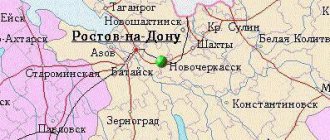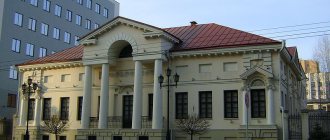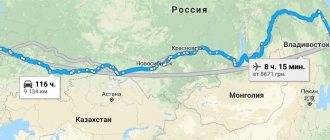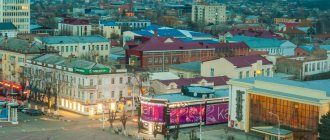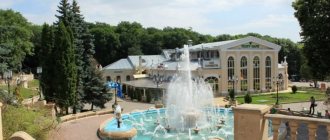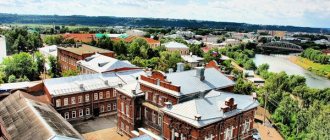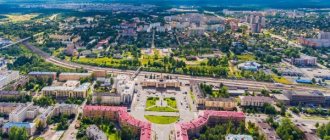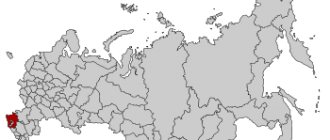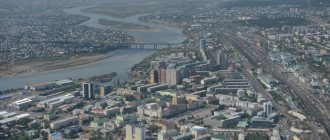- September 20, 2019
- Directions
- Molton
Kazan is a city on the European territory of the country, the capital of the Republic of Tatarstan. This is a large port city. Where is Kazan? This historical and cultural center is located on the left bank of the Volga River, in the area where the Kazanka River flows into it. One of the most successful cities in Russia, a major scientific, educational, cultural, economic, religious and sports center. The city has a long history, dating back over 1000 years. In the past it was the capital of the Kazan Khanate. Kazan is called the “third capital of Russia”.
Kazan gained the greatest fame as a city that has repeatedly hosted international sporting events in various sports. In 2022, a number of matches were held here as part of the FIFA World Cup.
Kazan is an important tourist center. According to this indicator, it ranks 3rd in Europe and 8th in the world. The city is also very popular among Russian tourists.
Kazan is a millionaire city. The number of inhabitants is approximately 1 million 250 thousand people. It is divided into 7 districts. City Day is celebrated on August 30.
Kazan city (Russia)
Kazan is one of the oldest cities in Russia, located in the Middle Volga on the Kazanka River. It is the capital of the Republic of Tatarstan and the largest city in the Volga region. Kazan is one of the most beautiful and interesting places in Russia, a city with a magnificent historical and cultural heritage. The most famous landmark of the capital of Tatarstan is the Kremlin, which is included in the list of UNESCO World Heritage Sites.
Kazan has a thousand-year history and is often called the “third capital of Russia”. Since ancient times, the city has been a kind of bridge between East and West, which has had an interesting effect on its architecture, culture and even atmosphere. Here, Christian churches coexist with Muslim mosques, magnificent ancient palaces with modern buildings, giving the capital of Tatarstan an amazing flavor.
Voronezh | 596 sq. kilometer
In 9th place in the top 10 largest Russian cities is Voronezh with an area of 596.51 square meters. kilometer The population is 1.3 million inhabitants. The city is located in a beautiful place - on the banks of the Don and the Voronezh reservoir. Voronezh has many beautiful architectural monuments, but it is also famous for its modern art. Sculptures of the kitten from Lizyukova Street, a character from the famous cartoon, and White Bim from the film “White Bim, Black Ear” were installed in the city. There is also a monument to Peter I in Voronezh.
Guides: Russia
Moscow
Saint Petersburg
May be interesting: Other cities in Russia
Moscow | 2561 sq. kilometers
The first place in the ranking is occupied by the capital of Russia, Moscow .
Territory – 2561.5 sq. kilometers, the population is more than 12 million people. To understand the full scale of the capital, you need to remember that Moscow has a larger population than some European countries. In addition to the largest Russian cities listed above, there are also urban settlements, when the city itself includes other settlements. If we consider these territorial units in our ranking, then Moscow or St. Petersburg will not be in first place. In this case, the list of the largest settlements in Russia will be headed by the city of Zapolyarny, whose area is 4620 square meters. kilometers. This is twice the area of the capital. Meanwhile, only 15 thousand people live in Zapolyarny. The Arctic is interesting because about 12 kilometers from the city there is the famous super-deep Kola well, which is one of the deepest points on Earth. The urban district of Norilsk can also lay claim to the title of the largest territorial association in Russia. It includes Norilsk itself and two settlements. Territory area – 4509 sq. kilometers.
86 44
Geography and climate
Kazan is located in the east of the European part of Russia, 800 km from Moscow. The capital of Tatarstan was built on the left bank of the Volga at the confluence of the Kazanka River, which divides the city into two parts: the southern historical part and the more modern northern part. The relief of Kazan is predominantly flat with low hills.
The climate of the city is temperate continental. It is characterized by relatively cold and snowy winters, as well as warm, slightly rainy summers. The best time to visit the capital of Tatarstan is from May to September.
Panorama of Kazan
Population dynamics
| Population | ||||||
| 1557 | 1800[5] | 1811 | 1840 | 1856 | 1858 | 1863 |
| 7000 | ↗40 000 | ↗53 900 | ↘41 300 | ↗56 300 | ↗61 000 | ↗63 100 |
| 1897[6] | 1907 | 1914 | 1917 | 1920 | 1923[7] | 1926[6] |
| ↗130 000 | ↗161 000 | ↗194 200 | ↗206 562 | ↘146 495 | ↗157 600 | ↗179 000 |
| 1931 | 1939[6] | 1956[8] | 1959[9] | 1962 | 1964 | 1966 |
| ↗200 900 | ↗406 000 | ↗565 000 | ↗646 806 | ↗711 000 | ↗742 000 | ↗804 000 |
| 1967[7] | 1970[10] | 1973 | 1975[11] | 1976[12] | 1979[13] | 1982 |
| ↗821 000 | ↗868 537 | ↗919 000 | ↗959 000 | →959 000 | ↗992 675 | ↗1 023 000 |
| 1985[14] | 1986[12] | 1987[15] | 1989[16] | 1990[17] | 1991[12] | 1992[12] |
| ↗1 051 000 | ↗1 060 000 | ↗1 068 000 | ↗1 094 378 | ↘1 094 000 | ↗1 105 000 | ↘1 104 000 |
| 1993[12] | 1994[12] | 1995[14] | 1996[14] | 1997[18] | 1998[14] | 1999[19] |
| ↘1 098 000 | ↘1 092 000 | ↘1 076 000 | →1 076 000 | ↗1 085 000 | ↘1 078 000 | ↗1 100 800 |
| 2000[20] | 2001[14] | 2002[21] | 2003[7] | 2004[22] | 2005[23] | 2006[24] |
| ↗1 101 000 | ↘1 090 200 | ↗1 105 289 | ↗1 105 300 | ↗1 106 900 | ↗1 110 000 | ↗1 112 700 |
| 2007[25] | 2008[26] | 2009[27] | 2010[28] | 2011[29] | 2012[30] | 2013[31] |
| ↗1 116 000 | ↗1 120 238 | ↗1 130 717 | ↗1 143 535 | ↗1 145 424 | ↗1 161 308 | ↗1 176 187 |
| 2014[32] | 2015[33] | 2016[34] | 2017[2] | |||
| ↗1 190 850 | ↗1 205 651 | ↗1 216 965 | ↗1 231 878 | |||
Story
The history of Kazan goes back more than a thousand years. Scientists believe that the settlement on the site of the modern city was founded around 1005. Initially, a fortress was built here on the northern border of Volga Bulgaria. In the 13th and 14th centuries, Kazan became an important center of the Golden Horde.
In 1391 the city was first mentioned in chronicles. In 1438, Kazan was captured by Khan Ulu-Mukhamed and became the capital of the Kazan Khanate. Over the next hundred years, the Khanate repeatedly fought with the Principality of Moscow and, ultimately, in 1552, Kazan was taken by Ivan the Terrible.
Kazan Kremlin
In 1556, construction of the Kremlin began here. By the 17th century, Kazan had become one of the most important cities in Russia, and at the beginning of the 18th century it became the capital of the Kazan province. A university was founded here in 1804.
Composition of the Russian Federation
The Russian Federation includes the following republics in 2022:
- Chuvashia;
- Adygea;
- Chechnya;
- Altai;
- Khakassia;
- Bashkortostan;
- Udmurtia;
- Buryatia;
- Tyva;
- Dagestan;
- Tatarstan;
- Ingushetia;
- Kabardino-Balkaria;
- North Ossetia Alania;
- Kalmykia;
- Yakutia;
- Karachay-Cherkessia;
- Mordovia;
- Karelia;
- Mari El Republic;
- Komi.
The last region to become part of Russia was Crimea. Today this republic is the most subsidized Russian region. Every year, up to 50 billion rubles are paid from the state budget to support the peninsula.
Composition of the Russian Federation on the map
How to get there
Kazan has a large international airport located 26 km south of the city. The capital of Tatarstan has regular air connections with most major cities in Russia, as well as cities in Turkey, Bulgaria, Greece, the UAE, and Thailand. In addition, Kazan is a major railway and transport hub. By car from Moscow you can get here via the M7 motorway.
Public transport in Kazan is represented by one metro line, numerous bus routes, tram and trolleybus lines. The Kazan metro includes only 10 stations. There are five tram routes.
Statistics by year
It is worth noting that the intraregional annual population growth in 2016 was -2418 people, in 2022 – 1683 people, in 2022 – 1219 people. The mortality rate is increasing every year, and the birth rate is decreasing. The growth rate over 1 year increased by 20.1 thousand or 0.68%.
The birth rate in the Republic is becoming lower every year. In 2019, the births of 19,684 children were registered, of which 99,098 were girls and 10,194 boys. This figure is very different from 2015, since 24,063 children were registered in that period; in 2016, 24,564 people were born; in 2022, 21,888 people were born. Demographic statistics indicate a decline in the birth rate throughout the country, not only in the republic.
Attractions
The Kazan Kremlin is the oldest part of the city and the most famous landmark of Kazan. It is a magnificent ensemble of historical, architectural and cultural monuments, surrounded by white stone walls. The origins of the Kazan Kremlin go back to the beginning of the 11th century, when a border Bulgarian fortress was built on this site. It acquired its current appearance in the 16th and 17th centuries, preserving several fragments from past periods.
The Kremlin in Kazan was built in the traditional Russian style by Pskov craftsmen, so its walls resemble a similar fortress in Pskov.
Kazan Kremlin
The Kremlin is located on the left bank of the Kazanka River on a hill. Its area is 15 hectares. The walls are 1.8 km long and reach 12 m in height. Eight towers and two gates have survived to this day.
The main attractions of the Kazan Kremlin
Syuyumbike
Syuyumbike is a high 58-meter brick watchtower, which is one of the architectural dominants of the Kremlin. Its exact date of construction is unknown. The first written mentions date back to 1777. The tower has a passage gate and is topped with a spire. Interestingly, Syuyumbike is a “leaning tower”. The deviation from the axis is about 2 m.
Kul Sharif
Kul-Sharif is the main mosque of Tatarstan, the construction of which was completed in 2005. Erected on the site of the historical mosque of the Crimean Khanate, destroyed during the capture of Kazan by the troops of Ivan the Terrible. Kul Sharif is built of granite and marble, has six minarets (four large and two small) and one dome.
Blagoveshchensky cathedral
The Annunciation Cathedral is the main Christian temple in Kazan and the oldest surviving monument of the Kremlin. It was built between 1555 and 1562 on the site of a wooden church, erected immediately after the capture of the capital of the Kazan Khanate. The cathedral was built by Pskov craftsmen and is a magnificent example of late medieval Russian architecture. In the 17th century, a high 50-meter bell tower was added to the church, but it was destroyed in 1928.
Spasskaya Tower
The Spasskaya Tower is the main tower of the Kazan Kremlin, built in the 16th century and has a height of almost 47 meters. It has four tiers and is built of white limestone. In the past, next to the tower there was a beautiful chapel, destroyed during Soviet times.
Taynitskaya Tower
The Tainitskaya Tower was built in the mid-16th century on the site of a hidden water source. During the time of the Kazan Khanate, the Nur Ali Tower was located on this site, through which Ivan the Terrible entered Kazan.
Southwest Tower
The South-West Tower is the same age as the Spasskaya Tower and was also built by Pskov craftsmen.
Presidential palace
The Presidential Palace is a beautiful historical building from the mid-19th century, built in the neo-Renaissance style (Russian-Byzantine style). The palace was once the residence of governors. During the time of the Kazan Khanate, the Khan's palace was located on this site.
Cannon Yard
The Cannon Yard is an ensemble of historical buildings from the 17th to 19th centuries in the Baroque and Classical styles. The complex was one of the largest places for the production and repair of artillery pieces in the Russian Empire and functioned until the mid-19th century.
Kremlin embankment
Kremlin Embankment is a colorful pedestrian street that begins at the walls of the Kremlin. It is one of the most popular places among residents and guests of the city for a walk. The embankment acquired its current appearance in 2013 - 2015.
Other sights of Kazan
Bauman Street is the central street of the historical center of Kazan, which begins at the Kremlin walls and stretches to Tukay Square. A huge number of architectural and cultural monuments are concentrated in its vicinity. This is also one of the oldest streets in Kazan. During the time of the Kazan Khanate, the Nogai tract ran here.
Bell tower of the Epiphany Cathedral
The Epiphany Cathedral was completely completed in 1756 and is located on Bauman Street in the depths of the courtyard. The temple was built in the Russian Baroque style and before the revolution had a richly decorated interior. What stands out in its architecture is the tall brick bell tower in the neo-Russian style, which for a long time was the tallest building in the historical center of Kazan.
Temple of all religions
The Temple of All Religions is a relatively modern architectural complex, built in 1994 and dedicated to all religions of the world. This colorful ensemble includes a Christian church, a Muslim mosque, a Jewish synagogue and a Buddhist pagoda.
Al-Marjani Mosque in Staro-Tatarskaya Sloboda
Staro-Tatarskaya Sloboda is a colorful historical district of Kazan, located between Lake Nizhny Kaban and the Bulak Canal. Its heart is Yunusovskaya Square. This part of Kazan is the historical center of the Tatar community (after the conquest of the city by Ivan Vasilyevich) and is a unique architectural ensemble of ancient buildings, palaces and mosques. Staro-Tatarskaya Sloboda is a great place to experience the culture of Tatarstan and see traditional Tatar architecture.
There are several ancient mosques in this area, among which al-Marjani stands out. This is one of the oldest mosques in Kazan, founded in the second half of the 18th century and for more than two centuries it has been the cathedral mosque of Tatarstan. Al-Marjani was built in the traditional Tatar style, has one minaret and predominantly Baroque architecture.
Tikhvin Temple
Tikhvin Church is one of the oldest churches in Kazan, located in the Staro-Tatarskaya Sloboda. The temple was founded at the end of the 17th century and rebuilt in neo-Russian style at the end of the 19th century.
Zilantov Monastery
The Zilantov (Uspensky) Monastery was founded in 1552 by Ivan the Terrible and is located approximately 5 km from the Kazan Kremlin on the hill of the same name. This hill plays a big role in the folklore of Kazan. According to legend, the winged serpent Zilant lived at its peak, which is now one of the symbols of the capital of Tatarstan.
The architectural ensemble of the monastery was formed in the 17th and 18th centuries and included several churches, a school and a seminary. During Soviet times, the monastery was closed, and its ancient buildings were practically destroyed. The All Saints Church of the 17th century has survived to this day, and relatively recently (in 2006) the Trinity Cathedral was erected.
Alexandrovsky Passage
Alexandrovsky Passage is one of the most striking buildings in Kazan in the style of eclectic architecture (modern and neo-baroque), built at the end of the 19th century by the merchant Alexandrov.
Farmers' Palace
The Farmers' Palace is an impressive modern landmark in the unusual bozar architectural style. The palace was built in 2010 near the Kremlin and the Kremlin embankment and in shape resembles the winter residence of the Habsburgs (Hofburg) in Vienna and the Altar of the Fatherland (Vittoriano) in Rome.
National Museum (right)
The National Museum is one of the oldest and largest museums in the Volga region. It was founded at the end of the 19th century, covers an area of more than 10,000 m2 and includes more than half a million exhibits. Archaeological artifacts, collections of porcelain, weapons, coins, art objects, old books and documents are presented here.
Peter and Paul Cathedral
The Peter and Paul Cathedral was built in Kazan in the first half of the 18th century in the Baroque style and is a striking example of the architecture of the era of Peter I. The temple also includes a 49-meter six-tier bell tower, decorated with beautiful Baroque decor. The interior of the church features a stunning iconostasis dating back to the 18th century.
Kazan
Kazan is a wedding palace opened in 2013. It has an original architecture, reminiscent of a traditional cast cooking pot. Nearby you can see several interesting sculptural compositions (a pair of zilants and leopards).
Perm | 800 sq. kilometers
Perm is in fourth place in the ranking of the largest cities in Russia by area . Occupies an area of 799.68 square meters. kilometers. The number of inhabitants is more than a million people. Perm is a large industrial, economic and logistics center. The city owes its foundation to Tsar Peter I, who ordered the construction of a copper smelter to begin in the Siberian province.

